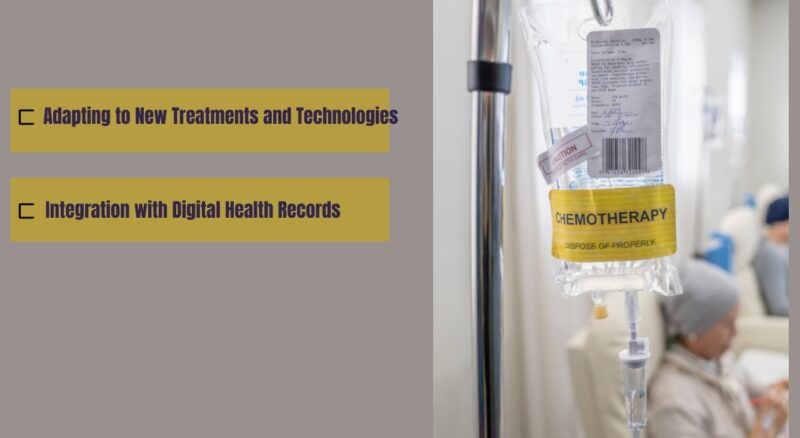Chemotherapy, a frontline treatment against various types of cancers, has undergone extensive research and development over the years. As these treatments have grown in diversity and complexity, so has the need for a standardized coding system to ensure they are correctly billed and documented.
This leads us to the intriguing world of J Codes. This guide aims to clarify the intricate web of J Codes associated with chemotherapy drugs, offering clarity for professionals and patients alike.
The Basics
J Codes fall under the Healthcare Common Procedure Coding System (HCPCS), a comprehensive collection of codes that categorize the vast array of medical services, equipment, and drugs used in the healthcare industry.
Origins and Purpose
The Healthcare Common Procedure Coding System (HCPCS) was developed by the Centers for Medicare & Medicaid Services (CMS). Within this system, J Codes represent a specific subset:
- These codes are dedicated to non-orally administered medication, supplies, and drugs.
- They serve multiple purposes, from ensuring accurate billing to maintaining consistent medical records.
What They Do in the Realm of Chemotherapy
Chemotherapy drugs, due to their specialized nature, are mainly administered through injectable or infusible methods. This makes them a significant category within the J Codes:
- They help identify the exact type and dosage of chemotherapy drugs.
- By doing so, they provide a clear trail for medical practitioners, insurers, and patients to track treatment and costs.
Decoding for Chemotherapy

With an understanding of what J Codes are, we can now delve into how they are structured and applied specifically to chemotherapy drugs.
Structure
J Codes are typically alphanumeric, starting with the letter ‘J’ followed by four digits. Here’s a basic breakdown:
- The first digit often indicates a category or group of drugs.
- Subsequent digits can refer to a specific drug or variation within that category.
For example:
- J9000 might refer to a general category of chemotherapy drugs.
- J9001 could be a specific drug within that category.
Applying to Specific Chemotherapy Drugs
Assigning J Codes to chemotherapy drugs is a meticulous process, considering the vast number of drugs and their variations:
- The drug’s name, manufacturer, dosage, and route of administration can influence its J Code.
- These codes are updated annually, accommodating new drugs and changes in existing ones.
The Importance of Accurate Application

While it might seem that J Codes are simply administrative tools, their accurate application has profound implications for patient care and the healthcare industry.
Ensuring Correct Billing and Reimbursement
The correct J Code ensures that providers are reimbursed accurately:
- It helps avoid billing discrepancies or potential disputes.
- Ensures that patients or their insurance are billed for the exact drug and dosage administered.
Maintaining Quality of Patient Care
Beyond billing, J Codes play a role in patient care:
- They allow for tracking of which drugs a patient has received, which is crucial for treatment plans and avoiding potential drug interactions.
- Regular updates to the J Code list ensure that new and innovative treatments are integrated into the system promptly.
Challenges and Considerations in Usage
Like any coding system, J Codes aren’t without their challenges. Being aware of these can help medical practitioners and administrators ensure smooth operations.
Keeping Up with Updates
Given the pace of medical advancements, the list of J Codes is continuously evolving:
- Annual updates might introduce new codes or revise existing ones.
- Healthcare providers need to stay updated to ensure they’re using the most recent codes.
Navigating Ambiguities
Not every chemotherapy drug might have a dedicated J Code:
- In such cases, a miscellaneous J Code might be used, which can create ambiguities.
- It’s vital to provide detailed documentation when using these codes to ensure clarity.
Future of J Codes in Chemotherapy

As we look towards the future of chemotherapy and the healthcare landscape, it’s worth considering how J Codes will adapt and what changes we might anticipate.
Adapting to New Treatments and Technologies
The medical field is in constant evolution, and J Codes need to keep pace:
- New chemotherapy treatments, especially targeted therapies and immunotherapies, will need their unique codes.
- The rise of personalized medicine, where treatments are tailored to an individual’s genetic makeup, may challenge the existing coding system. How do you code for a drug specifically designed for one individual?
Integration with Digital Health Records
The push for digitizing health records worldwide is gaining momentum:
- Seamless integration of J Codes into digital health systems will be crucial for smooth operations.
- This digital shift might also offer solutions like automatic updates of J Codes, reducing the manual overhead for healthcare providers.
Tips for Healthcare Professionals

For those in the healthcare sector dealing with J Codes daily, a few best practices can ensure accuracy and efficiency.
Regular Training and Updates
To keep up with the ever-evolving world of J Codes:
- Periodic training sessions for staff can ensure everyone is on the same page.
- Subscribing to updates from official sources like the Centers for Medicare & Medicaid Services can be invaluable.
- Utilize official resources for accurate J Code information.
- Attend seminars or webinars focused on HCPCS updates.
- Encourage team discussions about any challenges faced in the J Code application.
Auditing and Quality Checks
Implementing regular audits can catch discrepancies:
- Consider monthly or quarterly checks to review the accuracy of J Code usage.
- Feedback from these audits can serve as a training tool, highlighting common errors or areas of confusion.
Empowering Patients
While J Codes are primarily a tool for healthcare professionals, patients too can benefit from a basic understanding, especially when navigating insurance and billing.
Understanding Their Treatment Bills
With a grasp of J Codes, patients can better understand their treatment bills:
- Recognizing the specific drugs and dosages they were administered can give them confidence in their care.
- If discrepancies arise with insurance claims, having knowledge of J Codes can aid in resolution.
Being Proactive in Their Care
Knowledge is power. When patients understand the intricacies of their treatment:
- They can engage in more informed discussions with their healthcare providers.
- It allows them to be proactive, asking questions and ensuring they receive the best care possible.
FAQs

How Often Are J Codes Updated?
They are typically updated annually. However, interim updates can occur if there are significant changes or introductions of new drugs during the year.
It’s always advisable for healthcare professionals to stay tuned to official announcements from the Centers for Medicare & Medicaid Services.
Do All Countries Use J Codes for Chemotherapy Drugs?
No, they are part of the HCPCS system specific to the United States. Other countries may have their own coding systems in place to categorize and bill for medical services, including chemotherapy drugs.
Can a Drug Have More than One J Code Associated with It?
Generally, a specific drug will have one unique J Code. However, different dosages or formulations of the same drug might have different ones to differentiate them.
What Happens if A Chemotherapy Drug Doesn’t Have an Assigned J Code Yet?
In instances where a drug doesn’t have it designated, a miscellaneous J Code might be used. When this occurs, it’s crucial to provide additional documentation detailing the drug’s name, dosage, route of administration, and other pertinent details to ensure clarity and accurate billing.
Where Can Healthcare Providers Find Official Listings of J Codes?
The official list is available through the Centers for Medicare & Medicaid Services (CMS) website. Providers can access the HCPCS annual updates, as well as any interim changes, on the CMS platform.
Are J Codes only Used for Cancer Treatments?
No, while many of them pertain to chemotherapy drugs, the J Code system encompasses a wide range of non-oral medications and products across various medical fields. However, in the context of chemotherapy, they play a vital role in categorizing and billing for these specialized treatments.
Final Words
J Codes for chemotherapy drugs are more than just alphanumeric combinations; they’re a testament to the intricate and organized nature of the healthcare system. By ensuring accurate billing, fostering clear communication, and upholding the highest quality of patient care, J Codes, though often behind the scenes, play a pivotal role in the fight against cancer.
Whether you’re a healthcare professional, patient, or someone keenly interested in the industry’s inner workings, understanding J Codes offers a unique lens into the precision and dedication that goes into healthcare.

